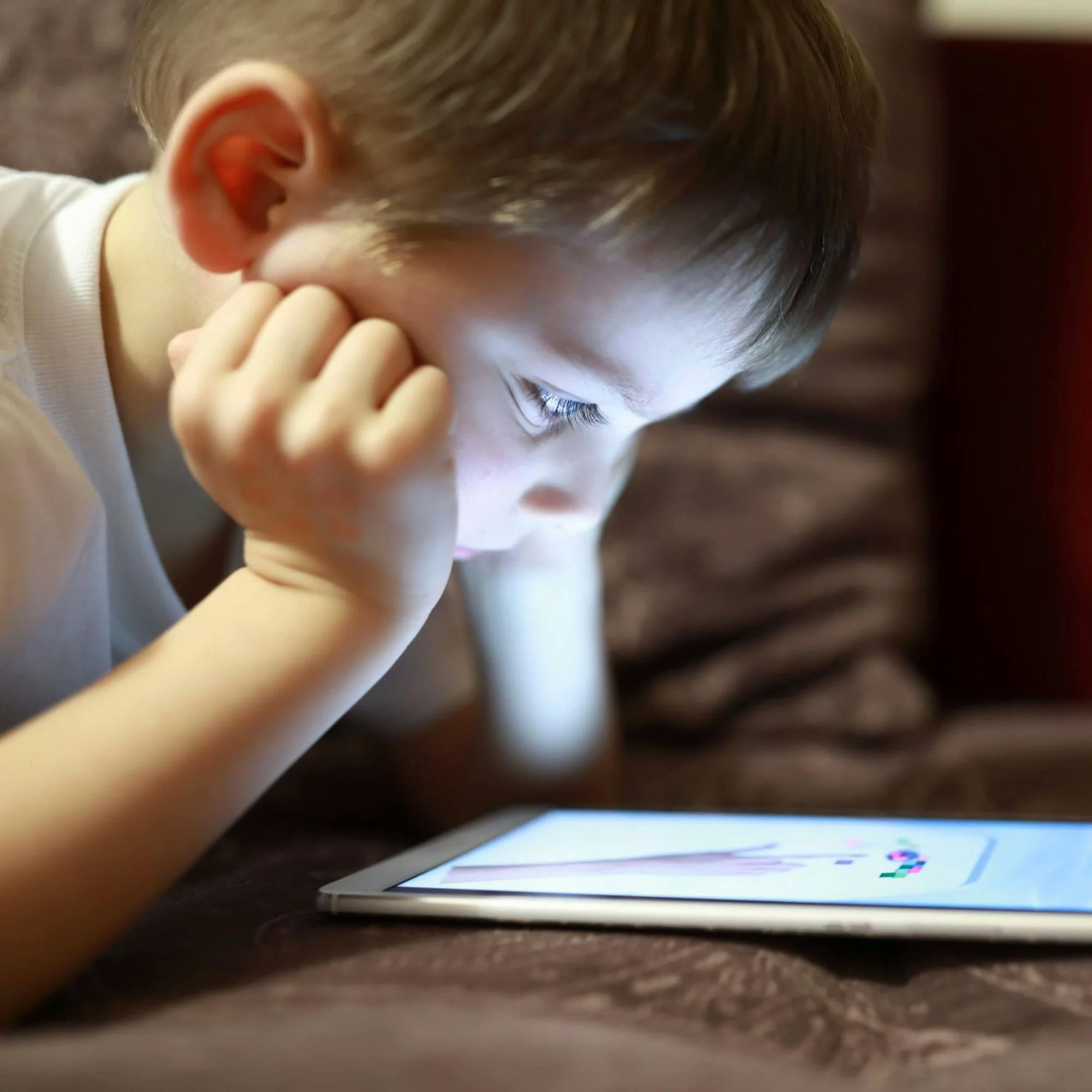
How Screen Time Impacts a Child's Speech and Language Development
 Leanne Sherred, M.S., CCC-SLP
Leanne Sherred, M.S., CCC-SLP
Children are inundated by screens and digital devices. Televisions, phones, tablets… they’re everywhere.
For parents, these devices can provide a quick distraction for a bored or upset child. They can also be a lifesaver in avoiding a public meltdown. But all this screen time adds up, and it can affect your child's language development.
How much time are kids spending on screens?
According to the National Center for Health Research, toddlers younger than age 2 spend, on average, two hours every day sitting idly in front of a screen. That number drastically increases as children get older, with 8- to 12-years-olds spending an average of six hours using screens. Teenagers spend up to nine hours a day!
This screen time phenomenon is coinciding with more and more children at risk for speech and language delays. After all, every hour spent using a screen is less time interacting face-to-face, reading, playing, or socializing with peers.
You may have questions surrounding your child’s digital usage. How will it affect their communication development? Is all screen time bad? How much is too much? Let’s dive in.


The difference between active and passive screen time
Not all screen time has a negative effect on the budding brains of children. It’s important to make a distinction between active and passive screen time.
Passive screen time is defined as “passively” consuming content with little interaction or engagement. Putting your child in front of a TV is a common example. There’s often no creativity or cognitive thought involved, and children aren’t encouraged to physically or mentally engage with what’s being shown. In other words, this type of screen time is largely sedentary.
Certain educational apps that involve two-way communication or language practice are wonderful examples of active screen time.
Active screen time, on the other hand, is the healthy part of a balanced screen time diet. It encourages your child to interact and stay engaged, and it stimulates their mind and creativity. Certain educational apps that involve two-way communication or language practice are wonderful examples of active screen time. So is video chatting with family members.
Speech therapy delivered online is another great example. With online speech therapy, children are actively engaged and participatory, sitting face-to-face with their speech therapist to practice speech and language skills.


How passive screen time affects a child's language development
While technology is innovating at a breakneck pace, the way that children learn to communicate remains the same. Foundational language development and speech skills come to children through listening, imitating, and interacting with people around them.
The first several years of a child’s life are critical. It’s when their brains are rapidly developing, and when your child is most receptive to learning language. The communication skills they develop now will stick with them for a lifetime.
Foundational language development comes to children through listening, imitating, and interacting with people around them.
Unfortunately, the more time your child spends sitting passively in front of a screen, the less time they spend interacting with the world around them. Think about taking a walk around the neighborhood. If your child is in their stroller watching their favorite show on a tablet, they're missing an opportunity to interact with you, ask questions, point to objects, learn new vocabulary words, and more.


The negative effects of passive screen time on language development have been well documented by researchers.
One study surveyed the effects of media exposure on over 1,000 toddlers younger than 2 years old. They found a strong link between media consumption and language development; the more videos that toddlers watched, the fewer words they knew or said. In fact, for each additional hour of videos that young children watched, they said on average six to eight fewer words--which adds up over time!
In one study, the more videos that toddlers watched, the fewer words they knew or said.
This study showed particularly devastating effects of passive screen time. Researchers found that before a child's first birthday, those who watched more than two hours of television a day were six times more likely to develop a language delay!


And finally, this study demonstrated that the more time children spent using handheld screens, such as tablets, phones, and electronic games, the more likely they were to develop a speech delay. More specifically, each additional 30 minutes they spent consumed by these devices translated into a 49% increase in the likelihood of delayed speech development.
One study showed that the more time children spent using handheld screens, the more likely they were to develop a speech delay.
In addition to affecting a child’s communication, passive screen time can also impact their mental health and social well-being. A study from the University of Michigan analyzed the screen habits of children between the ages of 4 and 11. They found that how children use these devices, not how much time they spend on them, had the strongest correlation on emotional and social problems.
Screen time recommendations for kids of different ages
While managing screen time may seem like another responsibility to put on the parenting checklist, it's so important for your child’s development. Of course, you can't remove screens entirely from your child's life. At the end of the day, moderation is what’s most important.
The American Academy of Pediatrics (AAP) provides some helpful recommendations on when and how to use screens with your child.
18 months and younger: Try to avoid screen time altogether. The only exception is video chatting with family, so long as your child is accompanied by an adult.
18-24 months: At this age, you can begin to introduce your toddler to some digital media. However, it’s not only important to limit their use, but also to choose high-quality educational programming. Watch these programs with your child so you can explain what’s on screen and ask stimulating questions throughout.
2-5 years of age: It’s not realistic to completely cut out all media. During this key developmental stage, AAP recommends limiting non-educational screen time to approximately one hour a weekday and three hours on the weekends. Again, try to watch television or play online games alongside your child. This way you can help your child connect what’s on screen to the real world.
Ages 6 and older: Continue to limit your child’s media diet and encourage healthy habits. Actively monitor their usage to ensure it’s not interfering with their school work, sleep, or other physical activities essential to raising a healthy kid.
Help your child form healthy screen habits
Regardless of your child’s age, there are many things you can do to encourage positive screen habits. It’s never too early (or late) to begin using these with your family!
Turn off screens during mealtime, family outings, and 30 to 60 minutes before bedtime.
Familiarize yourself with whatever programs your child is watching or games they’re playing. Ensure these are age-appropriate, and think about parental controls on your devices.
Try not to use screens to pacify bad behavior. While this can often be the quickest fix to avoid a temper tantrum, it can rapidly turn into a habit. If your child begins to “expect” screen time every time they cry, this habit will be hard to break!
Make all screen time as engaging as possible. As mentioned, try to watch media with your child, instead of sticking them in front of a TV or tablet and walking away. Talk about what they’re seeing on screen, ask questions, and make meaningful connections between the characters or events on screen and your child’s real life.
Set good examples with your own media consumption. If you’re prone to scrolling endlessly on social media (one of the most common examples of passive screen time), put your phone away when interacting with your child!
What if your child is already addicted to screens?
It happens! And once habits form, they’re hard to break cold turkey. While it’s unreasonable to think you can stop the addiction overnight, there are a few tips and tricks that can help.
First and foremost, it’s important to set some ground rules. You can try setting a maximum number of minutes/hours they can spend in front of a screen each day. Or, choose a time of day that screen time is allowed (such as an hour before dinnertime, then screens off).
If your child is old enough to understand, make sure to clearly explain why you’re limiting screen time. Screen time can also be used as a reward if your child does their chores, completes their homework, or spends time playing outside.
What’s most important is that you try to find activities that your child loves to replace their media consumption. This may take a bit of trial and error, but some ideas include:
Playing outside or at the park
Reading their favorite books
Singing songs or nursery rhymes
Working on a craft project, like sock puppets or modeling clay
Playing with toys or board games
Cooking together
Going on play dates with your friends
How Expressable Can Help
Concerned your child isn't reaching age-expected milestones? Looking for communication support from a professional? Expressable is a national online speech therapy practice serving children and adults. We treat all major areas of communication and feeding, offer flexible hours including evenings and weekends, and accept most major health insurance plans. We’re proud to have earned more than 3,000 5-star reviews from our clients (4.9/5 average).
Our therapy model is centered on parent and caregiver involvement. Research proves that empowering caregivers to participate in their loved one’s therapy leads to better outcomes. That’s why we combine live, 1-on-1 speech therapy with personalized education and home practice activities for faster progress.
Communication is more than words. It’s how we share how we feel and show who we are. We’re here to help you or your child do just that.









